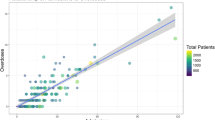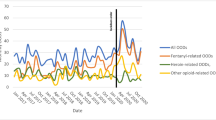Abstract
The current opioid epidemic continues to challenge us in new and potentially troubling ways. For example, research today finds more overdose deaths occurring in rural, rather than urban, geographic areas. Yet, studies have often ignored heterogeneities within these spaces and the neighborhood variations therein. Using geodemographic classification, we investigate neighborhood differences in overdose death rates by geographical areas to further understand where and among what groups the problem might be most concentrated. For deaths between 2013 and 2016, we find significant variation in rates among neighborhoods, defined by their socio-economic and demographic characteristics. For example, overdose death rates vary up to 13-fold among neighborhoods within geographic areas. Our results overall show that while the rural or urban classification of a geographic area is important in understanding the current overdose problem, a more segmented analysis by neighborhood’s socio-economic and demographic makeup is also necessary.


Similar content being viewed by others
Notes
Moreover, the approach allows us to address a methodological issue that has complicated neighborhood level research on overdose deaths in the US. Since the American Community Survey (ACS) has replaced the long form of the decennial census, it is the most prominent source for contextual information for geographic areas in the US [28, 34]. However, small scale data on the block group level or census tract level, which most closely align with our understandings of neighborhoods, show high levels of uncertainty [28, 34,35,36]. In geodemographic classification based on ACS data uncertainty for small scale data is reduced by using a composite of multiple variables [28].
The five-year 2011 ACS data conveniently aligns with the beginning of our study period 2013–2016 making the classification valuable for our investigation. Input, output, and validation data of Spielman and Singletons classification are available at https://www.openicpsr.org/openicpsr/project/100235/version/V5/view. R code for cluster analysis and data visualization is available at https://github.com/geoss/acs_demographic_clusters.
Delaware has 218 census tracts, four of these have no civilian population and were excluded from the analysis.
For instance, we found that the neighborhood type shows comparable scores to the wealthy-neighborhood types A and B when defined by a common concentrated disadvantage measure (http://www.amchp.org/programsandtopics/data-assessment/Documents/Tip%20Sheet_Concentrated%20Disadvantage_LC-06_Final.pdf) and fall into the same income quartile.
There were 851 overdose deaths among Delaware residents in the study period from 2013 to 2016. 64% of the decedents were male, 84% were white and the median age of the decedents was 43 years.
Person-years are calculated as four times the 2010 census population for the respective geographic areas or neighborhood types.
Neighborhood type A (Wealthy, Nuclear Families) was chosen as the reference category for the presentation of the rate ratios since the type is present in all geographic areas and allows for a quick estimate how a neighborhood fares compared to one of the most economically advantaged neighborhood type.
References
Center for Disease Control and Prevention (2017). CDC reports rising rates of drug overdose deaths in rural areas. CDC Newsroom. Retrieved May 1, 2018, from https://www.cdc.gov/media/releases/2017/p1019-rural-overdose-deaths.html.
Paulozzi, L. J., & Xi, Y. (2008). Recent changes in drug poisoning mortality in the United States by urban–rural status and by drug type. Pharmacoepidemiology and Drug Safety, 17(10), 997–1005.
Mack, K. A., Jones, C. M., & Ballesteros, M. F. (2017). Illicit drug use, illicit drug use disorders, and drug overdose deaths in metropolitan and nonmetropolitan areas—United States. Morbidity and Mortality Weekly Report, 66(19), 1–12.
Cicero, T. J., Ellis, M. S., Surratt, H. L., & Kurtz, S. P. (2014). The changing face of heroin use in the United States: A retrospective analysis of the past 50 years. JAMA Psychiatry, 71(7), 821–826.
Stewart, K., Cao, Y., Hsu, M. H., Artigiani, E., & Wish, E. (2017). Geospatial analysis of drug poisoning deaths involving heroin in the USA, 2000–2014. Journal of Urban Health, 94(4), 572–586.
Young, A. M., Havens, J. R., & Leukefeld, C. G. (2010). Route of administration for illicit prescription opioids: a comparison of rural and urban drug users. Harm Reduction Journal, 7, 24.
Dunn, K. E., Barrett, F. S., Yepez-Laubach, C., Meyer, A. C., Hruska, B. J., Petrush, K., Berman, S., Sigmon, S. C., Fingerhood, M., & Bigelow, G. E. (2016). Opioid overdose experience, risk behaviors, and knowledge in drug users from a rural versus an urban setting. Journal of Substance Abuse Treatment, 71, 1–7.
Dombrowski, K., & Khan, B. (2017) The scope and scale of rural drug use in Nebraska. In K. Dombrowski & K. Gocchi-Carrasco (Eds.), Reducing health disparities: Research updates from the field (pp. 59–77) Lincoln, NE: Syron Design Academic Publishing.
Cicero, T. J., Surratt, H., Inciardi, J. A., & Munoz, A. (2007). Relationship between therapeutic use and abuse of opioid analgesics in rural, suburban, and urban locations in the United States. Pharmacoepidemiology and Drug Safety, 16(8), 827–840.
Keyes, K. M., Cerdá, M., Brady, J. E., Havens, J. R., & Galea, S. (2014). Understanding the rural-urban differences in nonmedical prescription opioid use and abuse in the United States. American Journal of Public Health, 104(2), 52–59.
Cerdá, M., Gaidus, A., Keyes, K. M., Ponicki, W., Martins, S., Galea, S., & Gruenewald, P. (2017). Prescription opioid poisoning across urban and rural areas: identifying vulnerable groups and geographic areas. Addiction, 112(1), 103–112.
Rigg, K. K., & Monnat, S. M. (2015). Urban vs. rural differences in prescription opioid misuse among adults in the United States: Informing region specific drug policies and interventions. International Journal of Drug Policy, 26(5), 484–491.
Dombrowski, K., Crawford, D., Khan, B., & Tyler, K. (2016). Current rural drug use in the US Midwest. Journal of Drug Abuse, 2(3), 22.
Brady, J. E., Giglio, R., Keyes, K. M., DiMaggio, C., & Li, G. (2017). Risk markers for fatal and non-fatal prescription drug overdose: A meta-analysis. Injury Epidemiology, 4(1), 1–24.
Monnat, S. M., & Rigg, K. K. (2016). Examining rural/urban differences in prescription opioid misuse among US adolescents. The Journal of Rural Health, 32(2), 204–218.
Rossen, L. M., Khan, D., & Warner, M. (2014). Hot spots in mortality from drug poisoning in the United States, 2007–2009. Health & Place, 26, 14–20.
Tung, E. L., Cagney, K. A., Peek, M. E., & Chin, M. H. (2017). Spatial context and health inequity: Reconfiguring race, place, and poverty. Journal of Urban Health, 94(6), 757–763.
Galea, S., Ahern, J., Vlahov, D., Coffin, P. O., Fuller, C., Leon, A. C., & Tardiff, K. (2003). Income distribution and risk of fatal drug overdose in New York City neighborhoods. Drug and alcohol dependence, 70(2), 139–148.
Hannon, L., & Cuddy, M. M. (2006). Neighborhood ecology and drug dependence mortality: An analysis of New York City census tracts. The American Journal of Drug and Alcohol Abuse, 32, 453–463.
Visconti, A. J., Santos, G., Lemos, N. P., Burke, C., & Coffin, P. O. (2015). Opioid overdose deaths in the city and county of San Francisco: Prevalence, distribution, and disparities. Journal of Urban Health, 92(4), 758–772.
Rowe, C., Santos, G., Vittinghoff, E., Wheeler, E., Davidson, P., & Coffin, P. O. (2016). Neighborhood-level and spatial characteristics associated with lay Naloxone reversal events and opioid overdose deaths. Journal of Urban Health, 93(1), 117–130.
Marshall, J. R., Gassner, S. F., Anderson, C. L., Cooper, R. J., Lotfipour, S., & Chakravarthy, B. (2018). Socioeconomic and geographical disparities in prescription and illicit opioid-related overdose deaths in Orange County, California, from 2010 to 2014. Substance Abuse, 21, 1–7.
Galea, S., Ahern, J., Tardiff, K., Leon, A., Coffin, P. O., Derr, K., & Vlahov, D. (2003). Racial/ethnic disparities in overdose mortality trends in New York City, 1990–1998. Journal of Urban Health, 80(2), 201–211.
Denney, J. T., Onge, S., & Dennis, J. A. (2018). Neighborhood concentrated disadvantage and adult mortality: Insights for racial and ethnic differences. Population Research and Policy Review, 37(2), 301–321.
Hembree, C., Galea, S., Ahern, J., Tracy, M., Piper, M., Miller, T., Vlahov, J., D., & Tardiff, K. J. (2005). The urban built environment and overdose mortality in New York City neighborhoods. Health & Place, 11(2), 147–156.
Draus, P., & Carlson, R. G. (2009). Down on main street: Drugs and the small-town vortex. Health & Place, 15(1), 247–254.
Rhew, I. C., Hawkins, J. D., & Oesterle, S. (2011). Drug use and risk among youth in different rural contexts. Health & Place, 17(3), 775–783.
Spielman, S. E., & Singleton, A. (2015). Studying neighborhoods using uncertain data from the american community survey: A contextual approach. Annals of the Association of American Geographers, 105(3), 1003–1025.
Longley, P. A. (2016). Geodemographic profiling. International Encyclopedia of Geography, 1–11.
Singleton, A. D., & Spielman, S. E. (2014). The past, present, and future of geodemographic research in the United States and United Kingdom. The Professional Geographer, 66(4), 558–567.
Sleight, P. (1997). Targeting Customers: How to use Geodemographic and Lifestyle Data in Your Business. Henley-on-Thames: World Advertising Research Center.
Brueckner, J. K., & Rosenthal, S. S. (2009). Gentrification and neighborhood housing cycles: Will America’s future downtowns be rich? The Review of Economics and Statistics, 91(1), 725–743.
Ehrenhalt, A. (2012). The great inversion and the future of the American City. New York: Knopf.
Folch, D. C., Arribas-Bel, D., Koschinsky, J., & Spielman, S. E. (2014). Uncertain uncertainty: Spatial variation in the quality of American Community Survey estimates. Demography, 53(5), 1535–1554.
Spielman, S. E., Folch, D., & Nagle, N. (2014). Patterns and causes of uncertainty in the American Community Survey. Applied Geography, 46, 147–157.
Spielman, S. E., & Folch, D. C. (2015). Reducing uncertainty in the American Community Survey through data-driven regionalization. PLoS ONE, 10(2), e0115626.
Theobald, D. M. (2001). Land-use dynamics beyond the American urban fringe. Geographical Review, 91(3), 544–564.
Housing Assistance Council. (2012). Taking stock. Rural People, Poverty, and Housing in the 21st Century. Washington, DC: Housing Assistance Council.
Longley, P. (2005). Geographical Information Systems: a renaissance of geodemographics for public service delivery. Progress in Human Geography, 29(1), 57–63.
Longley, P. A., Goodchild, M. F., Maguire, D. J., & Rhind, D. W. (2015). Geographic information science and systems. New York: Wiley.
Reibel, M. (2011). Classification approaches in neighborhood research. Introduction and Review. Urban Geography, 32(3), 305–316.
Rothman, K. J., Greenland, S., & Lash, T. L. (2008). Modern epidemiology. Philadelphia: Lippincott Williams & Wilkins.
Consonni, D., Coviello, E., Buzzoni, C., & Mensi, C. (2012). A command to calculate age-standardized rates with efficient interval estimation. Stata Journal, 12(4), 688–701.
Tiwari, R. C., Clegg, L. X., & Zou, Z. (2006). Efficient interval estimation for age-adjusted cancer rates. Statistical Methods in Medical Research, 15(6), 547–569.
Acknowledgements
This study was supported by Bureau of Justice Assistance (Grant No. 2014-BM-PX-0002) and National Institute of Justice (Grant No. 2017-IJ-CX-0016). The results and discussion presented here do not necessarily reflect the views of our funders. We are grateful to our colleagues for feedback on earlier versions of this paper.
Author information
Authors and Affiliations
Corresponding author
Ethics declarations
Conflict of interest
None of the authors has a conflict of interest for the subject matter or data used in this paper.
Rights and permissions
About this article
Cite this article
Wagner, J., Neitzke-Spruill, L., O’Connell, D. et al. Understanding Geographic and Neighborhood Variations in Overdose Death Rates. J Community Health 44, 272–283 (2019). https://doi.org/10.1007/s10900-018-0583-0
Published:
Issue Date:
DOI: https://doi.org/10.1007/s10900-018-0583-0




